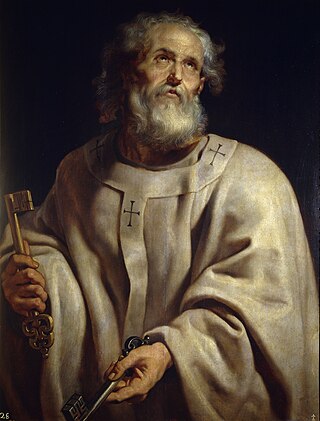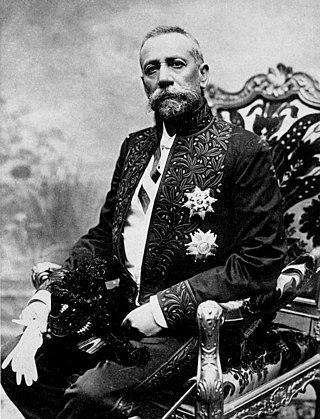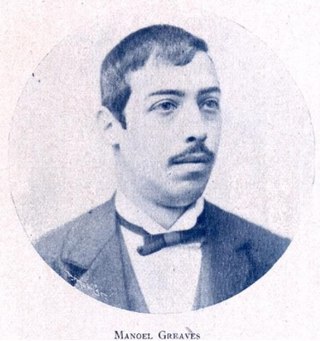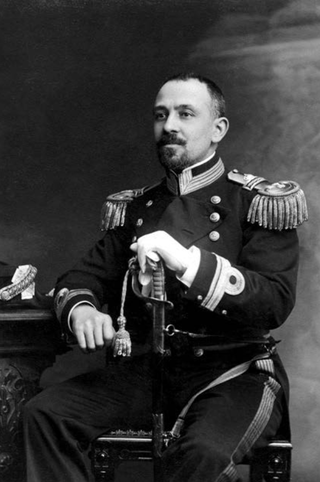Frequent persons on Azores's street signs
countries
24 names / 66 streets
Saint Peter
 7
Saint Peter, also known as Peter the Apostle, Simon Peter, Simeon, Simon, or Cephas, was one of the Twelve Apostles of Jesus Christ and one of the first leaders of the early Christian Church. He...
7
Saint Peter, also known as Peter the Apostle, Simon Peter, Simeon, Simon, or Cephas, was one of the Twelve Apostles of Jesus Christ and one of the first leaders of the early Christian Church. He...
John the Baptist
 7
John the Baptist was a Jewish preacher active in the area of the Jordan River in the early 1st century AD. He is also known as Saint John the Forerunner in Eastern Orthodoxy, John the Immerser in...
7
John the Baptist was a Jewish preacher active in the area of the Jordan River in the early 1st century AD. He is also known as Saint John the Forerunner in Eastern Orthodoxy, John the Immerser in...
Prince Henry the Navigator
 4
Dom Henrique of Portugal, Duke of Viseu, better known as Prince Henry the Navigator, was a central figure in the early days of the Portuguese Empire and in the 15th-century European maritime...
4
Dom Henrique of Portugal, Duke of Viseu, better known as Prince Henry the Navigator, was a central figure in the early days of the Portuguese Empire and in the 15th-century European maritime...
Almeida Garrett
 3
João Baptista da Silva Leitão de Almeida Garrett, 1st Viscount of Almeida Garrett was a Portuguese poet, orator, playwright, novelist, journalist, politician, and a peer of the realm. A major...
3
João Baptista da Silva Leitão de Almeida Garrett, 1st Viscount of Almeida Garrett was a Portuguese poet, orator, playwright, novelist, journalist, politician, and a peer of the realm. A major...
Francis of Assisi
 3
Giovanni di Pietro di Bernardone, known as Francis of Assisi, was an Italian mystic, poet and Catholic friar who founded the religious order of the Franciscans. He was inspired to lead a Christian...
3
Giovanni di Pietro di Bernardone, known as Francis of Assisi, was an Italian mystic, poet and Catholic friar who founded the religious order of the Franciscans. He was inspired to lead a Christian...
Alexandre de Serpa Pinto
 3
Alexandre Alberto da Rocha de Serpa Pinto, Viscount of Serpa Pinto was a Portuguese explorer of southern Africa and a colonial administrator.
3
Alexandre Alberto da Rocha de Serpa Pinto, Viscount of Serpa Pinto was a Portuguese explorer of southern Africa and a colonial administrator.
Albert I, Prince of Monaco
 3
Albert I was Prince of Monaco from 10 September 1889 until his death in 1922. He devoted much of his life to oceanography, exploration and science. Alongside his expeditions, Albert I made reforms on...
3
Albert I was Prince of Monaco from 10 September 1889 until his death in 1922. He devoted much of his life to oceanography, exploration and science. Alongside his expeditions, Albert I made reforms on...
José Agostinho
 3
José Agostinho, mais conhecido por tenente-coronel José Agostinho, foi um militar de carreira que se distinguiu como meteorologista e naturalista de renome internacional. Publicou algumas centenas de...
3
José Agostinho, mais conhecido por tenente-coronel José Agostinho, foi um militar de carreira que se distinguiu como meteorologista e naturalista de renome internacional. Publicou algumas centenas de...
Anthony the Great
 3
Anthony the Great was a Christian monk from Egypt, revered since his death as a saint. He is distinguished from other saints named Anthony, such as Anthony of Padua, by various epithets: Anthony of...
3
Anthony the Great was a Christian monk from Egypt, revered since his death as a saint. He is distinguished from other saints named Anthony, such as Anthony of Padua, by various epithets: Anthony of...
Saint Amaro
 2
According to Catholic tradition, Saint Amaro or Amarus the Pilgrim was an abbot and sailor who it was claimed sailed across the Atlantic Ocean to an earthly paradise. There are two historical figures...
2
According to Catholic tradition, Saint Amaro or Amarus the Pilgrim was an abbot and sailor who it was claimed sailed across the Atlantic Ocean to an earthly paradise. There are two historical figures...
Alfredo da Silva Sampaio
 2
Alfredo da Silva Sampaio foi médico e naturalista, tendo-se notabilizado pela publicação da obra Memória sobre a Ilha Terceira, uma vasta monografia sobre a história natural, geologia, geografia e...
2
Alfredo da Silva Sampaio foi médico e naturalista, tendo-se notabilizado pela publicação da obra Memória sobre a Ilha Terceira, uma vasta monografia sobre a história natural, geologia, geografia e...
Teotónio Machado Pires
 2
Teotónio Machado Pires GOC • GOIH foi um jurista, advogado e político ligado ao Estado Novo, que entre outras funções de relevo foi deputado e governador civil do Distrito Autónomo de Angra do...
2
Teotónio Machado Pires GOC • GOIH foi um jurista, advogado e político ligado ao Estado Novo, que entre outras funções de relevo foi deputado e governador civil do Distrito Autónomo de Angra do...
Gonçalo Velho Cabral
 2
Gonçalo Velho Cabral was a Portuguese monk and Commander in the Order of Christ, explorer and hereditary landowner responsible for administering Crown lands on the same islands, during the Portuguese...
2
Gonçalo Velho Cabral was a Portuguese monk and Commander in the Order of Christ, explorer and hereditary landowner responsible for administering Crown lands on the same islands, during the Portuguese...
João Joaquim André de Freitas
 2
João Joaquim André de Freitas, mais conhecido por Senador André de Freitas, foi um político e benemérito açoriano, de origem florentina. Iniciou a sua carreira política como deputado eleito pelo...
2
João Joaquim André de Freitas, mais conhecido por Senador André de Freitas, foi um político e benemérito açoriano, de origem florentina. Iniciou a sua carreira política como deputado eleito pelo...
Marquês de Ávila
 2
Marquês de Ávila é um título nobiliárquico criado por D. Luís I de Portugal, por Decreto de 24 e Carta de 31 de Maio de 1870, em favor de António José de Ávila, antes 1.º Conde de Ávila e depois 1.°...
2
Marquês de Ávila é um título nobiliárquico criado por D. Luís I de Portugal, por Decreto de 24 e Carta de 31 de Maio de 1870, em favor de António José de Ávila, antes 1.º Conde de Ávila e depois 1.°...
Manuel de Arriaga
 2
Manuel José de Arriaga Brum da Silveira e Peyrelongue was a Portuguese lawyer, the first attorney-general and the first elected president of the First Portuguese Republic, following the deposition of...
2
Manuel José de Arriaga Brum da Silveira e Peyrelongue was a Portuguese lawyer, the first attorney-general and the first elected president of the First Portuguese Republic, following the deposition of...
Jesus
 2
Jesus, also referred to as Jesus Christ, Jesus of Nazareth, and many other names and titles, was a first-century Jewish preacher and religious leader. He is the central figure of Christianity, the...
2
Jesus, also referred to as Jesus Christ, Jesus of Nazareth, and many other names and titles, was a first-century Jewish preacher and religious leader. He is the central figure of Christianity, the...
Dinis da Luz
 2
Dinis da Luz de Medeiros (São Pedro Nordestinho, ilha de São Miguel, 8 de setembro de 1915 — São Pedro Nordestinho, 20 de dezembro de 1988, mais conhecido por Dinis da Luz, foi um sacerdote católico,...
2
Dinis da Luz de Medeiros (São Pedro Nordestinho, ilha de São Miguel, 8 de setembro de 1915 — São Pedro Nordestinho, 20 de dezembro de 1988, mais conhecido por Dinis da Luz, foi um sacerdote católico,...
John II of Portugal
 2
John II, called the Perfect Prince, was King of Portugal from 1481 until his death in 1495, and also for a brief time in 1477. He is known for re-establishing the power of the Portuguese monarchy,...
2
John II, called the Perfect Prince, was King of Portugal from 1481 until his death in 1495, and also for a brief time in 1477. He is known for re-establishing the power of the Portuguese monarchy,...
Manuel da Silva Greaves
 2
Manuel da Silva Greaves foi um escritor e jornalista açoriano, autor de uma vasta obra de temática açoriana.
2
Manuel da Silva Greaves foi um escritor e jornalista açoriano, autor de uma vasta obra de temática açoriana.
Teófilo Braga
 2
Joaquim Teófilo Fernandes Braga was a Portuguese writer, playwright, politician and the leader of the Republican Provisional Government after the overthrow of King Manuel II, as well as the second...
2
Joaquim Teófilo Fernandes Braga was a Portuguese writer, playwright, politician and the leader of the Republican Provisional Government after the overthrow of King Manuel II, as well as the second...
Jácome de Bruges
 2
Jácome de Bruges, 1st Captain-Donee of Terceira was the brother of Louis de Gruuthuse, 1st Earl of Winchester of the wealthy Gruuthuse noble family from Bruges, their grandfather Jean III d'Aa of...
2
Jácome de Bruges, 1st Captain-Donee of Terceira was the brother of Louis de Gruuthuse, 1st Earl of Winchester of the wealthy Gruuthuse noble family from Bruges, their grandfather Jean III d'Aa of...
Gago Coutinho
 2
Carlos Viegas Gago Coutinho, GCTE, GCC, generally known simply as Gago Coutinho, was a Portuguese geographer, cartographer, naval officer, historian and aviator. An aviation pioneer, Gago Coutinho...
2
Carlos Viegas Gago Coutinho, GCTE, GCC, generally known simply as Gago Coutinho, was a Portuguese geographer, cartographer, naval officer, historian and aviator. An aviation pioneer, Gago Coutinho...
Saint Lucy
 2
Lucia of Syracuse (283–304), also called Saint Lucia was a Roman Christian martyr who died during the Diocletianic Persecution. She is venerated as a saint in Catholic, Anglican, Lutheran, and...
2
Lucia of Syracuse (283–304), also called Saint Lucia was a Roman Christian martyr who died during the Diocletianic Persecution. She is venerated as a saint in Catholic, Anglican, Lutheran, and...